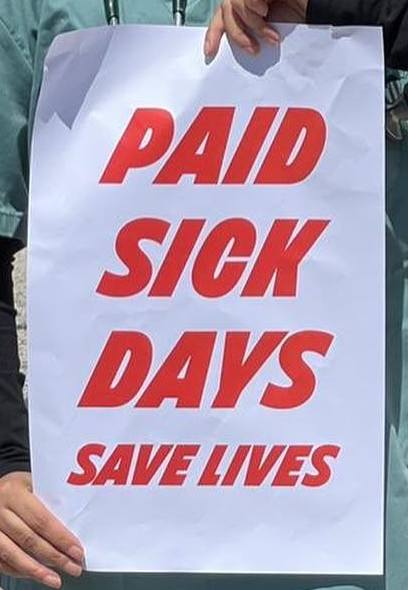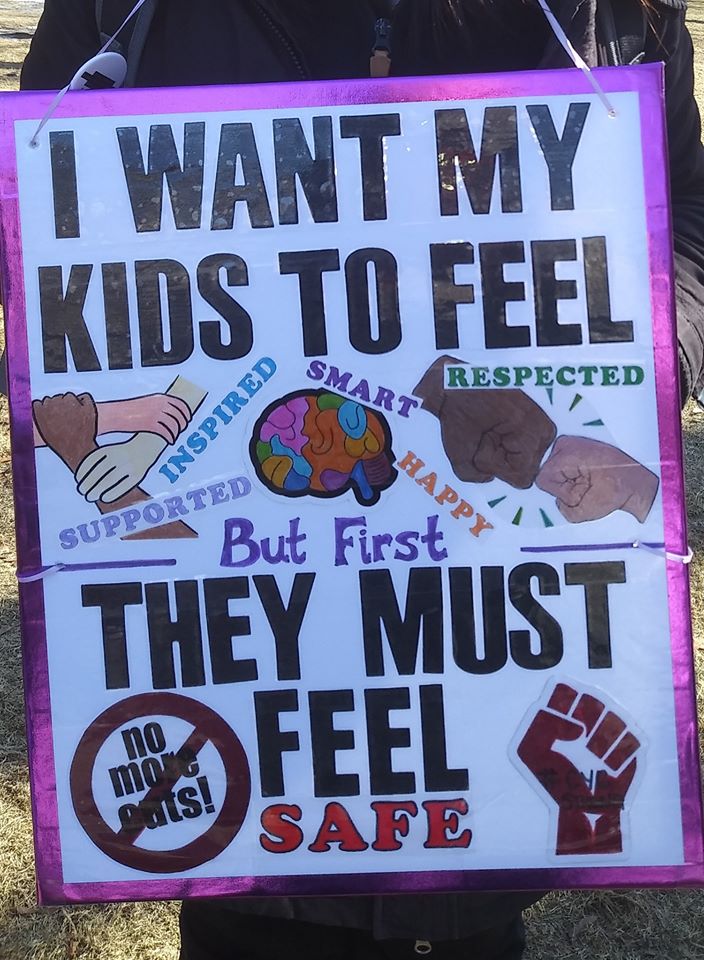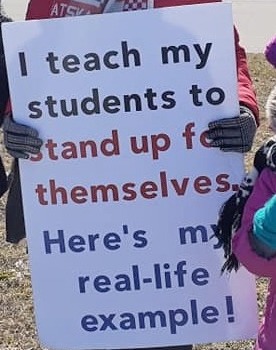|
May 10, 2021 - No 42
Education
What Teachers and Education Workers Are
Learning Through the Pandemic
- Laura Chesnik -
  
• Where
Things Stand in K-12 Education in Ontario
- Enver Villamizar
Education
- Laura Chesnik -
Laura Chesnik is an elementary teacher in
Ontario and a host of the Education
is a Right Podcast.
A major focus of our work since last May Day
has been to lift the
pressure on our peers that our role in this
pandemic is to be good
critics of the government. We need to find ways
to put in place
solutions by discussing what we are all facing
and how we can make a
difference.
 In Ontario the
first issue we faced after the initial shutdown
in March 2020 was
how to affirm our right to safe working
conditions when we know the
virus is spreading in our communities and it
will come into our schools
if we are not very vigilant. On the podcast
Education Is a Right we
began taking up this discussion directly in
terms of how it
poses itself in education: what it means to
refuse unsafe work, how to
refuse, and what happens when one does. For
educators, the right to
refuse is a bit different than in other sectors;
we have exceptions as
we come under the Education Act and we have a
"duty of care" for our
students, which means we must ensure they are
supervised before we
engage in a work refusal. So this created
hesitation, that somehow we
could not refuse. It also created the sense that
by refusing we would
be giving up our duty of care for our students.
There is also the
pressure that the Occupational Health and Safety Act
does not allow you
to refuse based on a general fear or concern; it
has to be based on a
specific concern that you personally have, that
will directly affect
you. It is as if you have to be able to prove
the virus is in your air
before you can legitimately refuse under these
existing arrangements.
So this too imposed the pressure that it is not
possible or worth it to
say No to try and bring in proper safety
measures. In Ontario the
first issue we faced after the initial shutdown
in March 2020 was
how to affirm our right to safe working
conditions when we know the
virus is spreading in our communities and it
will come into our schools
if we are not very vigilant. On the podcast
Education Is a Right we
began taking up this discussion directly in
terms of how it
poses itself in education: what it means to
refuse unsafe work, how to
refuse, and what happens when one does. For
educators, the right to
refuse is a bit different than in other sectors;
we have exceptions as
we come under the Education Act and we have a
"duty of care" for our
students, which means we must ensure they are
supervised before we
engage in a work refusal. So this created
hesitation, that somehow we
could not refuse. It also created the sense that
by refusing we would
be giving up our duty of care for our students.
There is also the
pressure that the Occupational Health and Safety Act
does not allow you
to refuse based on a general fear or concern; it
has to be based on a
specific concern that you personally have, that
will directly affect
you. It is as if you have to be able to prove
the virus is in your air
before you can legitimately refuse under these
existing arrangements.
So this too imposed the pressure that it is not
possible or worth it to
say No to try and bring in proper safety
measures.
Early on in the school year, the Ministry of
Labour kept dismissing
things, claiming that without proof of the virus
in the school itself,
you do not have a valid reason to refuse.
Refusals were transformed
into what are called "complaints." Complaints
were registered and
recorded but we saw this was done using form
letters that did not even
accurately document the actual complaint. For
example, despite all the
knowledge that the virus spreads via aerosols,
it stated right on the
form letter that there is no evidence the virus
spreads in the air
through ventilation systems. The government's
claims of no proof of the
virus spreading in schools comes alongside its
refusal to do mass
testing
in the workplaces to even know if COVID-19 is in
the schools and find
out how it is traveling.
 We
can see that the existing arrangements for
health and safety which put
everything on the individual -- either the
worker or the supervisor --
do not protect us unless we have organization.
They are meant to keep
everyone isolated, making it a "choice" whether
to uphold your rights
or not. In fact, it is through working things
out together that
we can see that it is a social responsibility to
refuse unsafe work and
to make it safe. Yet, the whole system is set up
to say that you as an
individual have to have a legitimate fear for
your own personal health
and safety and cannot do a refusal "for others."
It is aimed at
preventing a collective expression of NO
to conditions that are unsafe
by reducing everyone to their own island, making
their own choice. But,
as people take stands it necessarily becomes an
issue for everyone, so
taking a stand is the starting point. We
can see that the existing arrangements for
health and safety which put
everything on the individual -- either the
worker or the supervisor --
do not protect us unless we have organization.
They are meant to keep
everyone isolated, making it a "choice" whether
to uphold your rights
or not. In fact, it is through working things
out together that
we can see that it is a social responsibility to
refuse unsafe work and
to make it safe. Yet, the whole system is set up
to say that you as an
individual have to have a legitimate fear for
your own personal health
and safety and cannot do a refusal "for others."
It is aimed at
preventing a collective expression of NO
to conditions that are unsafe
by reducing everyone to their own island, making
their own choice. But,
as people take stands it necessarily becomes an
issue for everyone, so
taking a stand is the starting point.
We have seen that while it may seem impossible
at first to even
consider how to empower oneself under these
circumstances, there is
always a way forward, you just have to keep
talking about it, arguing
it out and seeing what is possible.
So we began discussing openly how this issue of
refusing posed
itself, what it means to refuse, and that it is
not an issue of
refusing work per
se, or just going through the motions.
It is refusing
to go along with something that is unacceptable
and trying to find
alternatives by affirming our right to
conscience and freedom of speech.
We informed ourselves and our audience of the
experiences of those
who took a stand across the province and we also
had our own
experiences with this whole process. We realized
that, in fact, a
refusal and even a threat of a refusal does a
lot. For example, it
brings the conditions to the attention of
parents, other staff and the
administration.
It does not permit things to continue unspoken.
And it reveals the
absurdity of the situation in which there are
outbreaks in the schools
but the Ministry of Labour inspectors say there
is no evidence of the
virus in the schools and the Minister of
Education insists schools are
not a source of transmission.
The issue we are taking up now is that it is
not a choice whether to
go along with unsafe conditions or not. It is a
duty to not accept
conditions that are unsafe and we should take up
this duty without
hesitation for ourselves, our colleagues, our
students and the society
as a whole.
 Teachers
and education workers in different parts of the
province have started
now taking stands collectively in their
workplaces to refuse to go in
if it is not safe to do so and if measures are
not taken to make them
safe. Some took the decision to refuse as a
group, others took the
decision to raise concerns and threaten a
refusal if their
concerns were not addressed. These actions
resulted in changes being
made in the workplaces, including the
establishment of committees for
reviewing safety that are not official but have
been set up to allow
workers to have their say about what is needed.
In many cases
administrators and parents have been very
supportive, in fact even
thanking
people for doing work refusals or threatening a
refusal. Teachers
and education workers in different parts of the
province have started
now taking stands collectively in their
workplaces to refuse to go in
if it is not safe to do so and if measures are
not taken to make them
safe. Some took the decision to refuse as a
group, others took the
decision to raise concerns and threaten a
refusal if their
concerns were not addressed. These actions
resulted in changes being
made in the workplaces, including the
establishment of committees for
reviewing safety that are not official but have
been set up to allow
workers to have their say about what is needed.
In many cases
administrators and parents have been very
supportive, in fact even
thanking
people for doing work refusals or threatening a
refusal.
The stands taken by doctors, nurses, scientists
and other
professionals with relevant expertise who are
speaking out, calling for
changes to make schools safer, to have mass
testing, smaller class
sizes, improved ventilation, or to close schools
and provide the
necessary supports for families has also made a
difference. It has
given teachers and
education workers a lot more confidence that we
are not alone in being
concerned, that medical and scientific
professionals are taking up
their duty too. It is one fight.
Our experience is showing that by putting the
problems on the agenda
for everyone and having a way to inform one
another, nothing is
impossible. The work of the Workers' Centre to
do this nationally is
very important. We can see from our own
experience and the experience
of others across the country that solutions can
be found, but it
starts by taking a stand to not accept what is
unacceptable.

- Enver Villamizar -

Picket in Windsor during one-day strikes by
teachers and education workers, February 21,
2020.
Enver
Villamizar is a high school teacher in
Ontario and a host of the Education
is a Right Podcast.
At this point schools in Ontario have been
closed indefinitely
since April 12 which was the start of the spring
break. It is important
to note that special education classes and staff
continue to be working
in the schools as do custodians and other
maintenance staff, along with
some administrative and clerical staff. In one
case all but one of a
whole crew of custodians at a school that was
"closed" became infected
with COVID-19. So the idea that schools are all
closed and everything
is fine still shows that the protections
required when people
congregate have not been consistently put in
place, so that even when
most students and staff are not present, the
virus gets in.
Prior to this latest shutdown all kinds of
discussion was breaking
out about whether to refuse to work when the
spring break ended, how to
refuse, and what that means for the entire
school body. The threat of
mass work refusals is something the school
boards, the unions and the
government see as a concern on their radar. It
is likely one of
the reasons that a number of boards closed their
schools before the
government acted, as the system is hanging on by
a thread at the moment
with a lack of supply teachers, people off on
leaves, etc. Any refusal
can shut down a school and a few of them can
shut down a whole board.
With the threat of a number of refusals, some
school boards
therefore shut down all their schools
pre-emptively.
 In
response to persistent demands from educators,
the government has
announced that they can all now schedule
appointments for a first dose
of the vaccine, and those who did not have paid
sick leave now have
access to three paid sick days. This seems like
a set-up to say that
now everything is fine and the rest is up to
you. This is not a plan
to actually ensure the timely vaccination of
teachers and education
workers, at their place of work, for example,
which would mean a
guarantee, and that they will not have to line
up or wait for a time
when the shot is available for them. In
response to persistent demands from educators,
the government has
announced that they can all now schedule
appointments for a first dose
of the vaccine, and those who did not have paid
sick leave now have
access to three paid sick days. This seems like
a set-up to say that
now everything is fine and the rest is up to
you. This is not a plan
to actually ensure the timely vaccination of
teachers and education
workers, at their place of work, for example,
which would mean a
guarantee, and that they will not have to line
up or wait for a time
when the shot is available for them.
A big demand now is that unless changes are
made so that educators
are fully vaccinated, have N95 masks and other
necessary PPE, that
ventilation is sorted out, not on a school-wide
basis but on a class by
class basis, with adequate paid sick days in
place for all staff and
parents who need to isolate at home, schools
cannot re-open for
everyone.
The Ontario government's recent announcement
that it will pay for
three COVID-related sick days from April 19 to
September 25, 2021 is an
attempt to appear to be addressing the demands
of the people. But it is
too little too late, widely seen as an act of
political expediency to
quell the growing outcry against its refusal to
heed the advice of
even its own medical advisors. It cannot be seen
as a serious attempt
to deal with how to ensure people can comply
with public health
protocols like staying home if they are
symptomatic, are waiting for
test results or have been in close contact with
an infected person. And
while the government will try to claim it has
done its part to allow
people
who are sick to stay home, it refuses to address
how to prevent people
from getting sick in the first place, which is
the starting point of
its social responsibility.

(To access articles
individually click on the black headline.)
PDF
PREVIOUS
ISSUES | HOME
Website: www.cpcml.ca
Email: office@cpcml.ca
|

